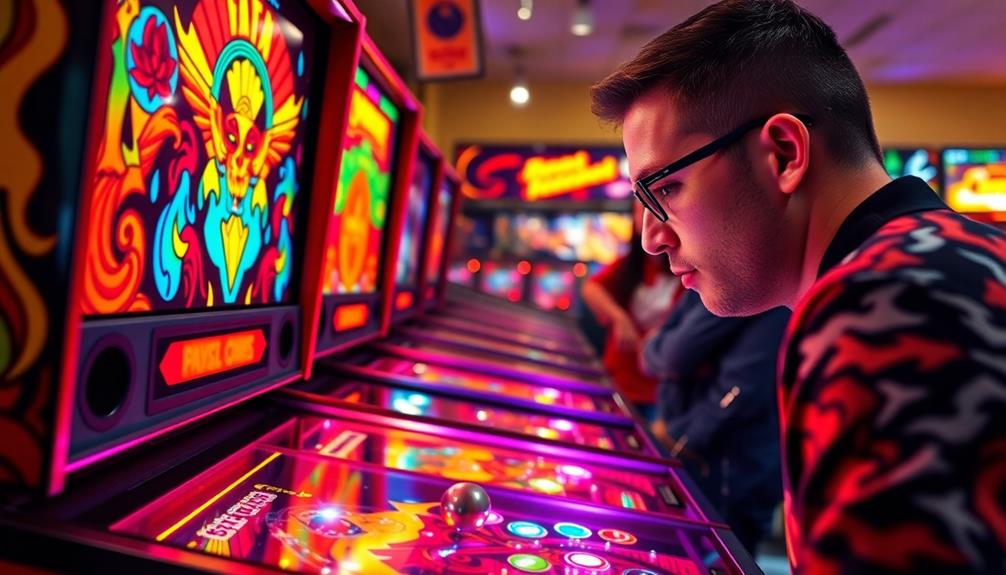A tilt in pinball is a crucial anti-cheat mechanism that comes into play when you push or nudge the machine too forcefully. This feature is activated by a pendulum that detects movement and issues warnings. Typically, you will receive up to three warnings before the tilt function is triggered, causing your flippers to stop working and ending your turn. The sensitivity of the tilt feature varies from machine to machine, so it is important to be mindful of your nudging in order to maintain control of the game. Mastering this aspect can significantly improve your performance, and experimenting with effective nudging techniques can lead to even better gameplay strategies.
Key Takeaways
- Tilt is an anti-cheat mechanism in pinball machines that activates when excessive nudging occurs.
- Players receive up to three warnings before the game fully tilts, ending their turn.
- The tilt mechanism operates through a pendulum system that detects excessive movements.
- Effective nudging can enhance ball control, but players must manage tilt warnings to avoid penalties.
- The tilt system has evolved from basic mechanisms to advanced electronic sensors for accurate detection.
Definition of Tilt
Tilt, functioning as an anti-cheat mechanism in pinball machines, activates when you nudge or push the cabinet too much to influence the ball's path. This tilt mechanism is essential for maintaining fair play and preventing players from manipulating the game excessively. This feature ensures that the outcome of the game is determined by the player’s skill and accuracy rather than by unfair tactics. The tilt mechanism is also a way to protect the internal components of the pinball machine from damage caused by excessive force. This is why pinball machines tilt, serving as a safeguard for both player fairness and the machine’s longevity.
When you apply force to the machine, a pendulum system detects the movement and issues tilt warnings if you push it too far. Understanding the importance of content quality and topical authority can enhance your pinball experience by guaranteeing you play fairly and strategically.
If you receive multiple tilt warnings, the game can trigger a full tilt, which disables the flipper power. This means you could lose a ball, ending your current play session prematurely.
The sensitivity of the tilt mechanism can vary, so some machines might respond quicker to player nudges than others. Understanding how the tilt mechanism works can help you strategize your gameplay while avoiding those frustrating penalties.
Ultimately, the tilt mechanism guarantees everyone plays by the same rules, keeping the integrity of the pinball experience intact.
Mechanism of Action

The tilt mechanism operates through a clever pendulum system that detects excessive movements of the pinball machine. This system is vital for maintaining the integrity of gameplay while allowing you, the player, some leeway to nudge the pinball table.
Understanding the balance between risk and reward is fundamental, similar to the concept of investment strategies. Here's how it works:
- The pendulum has a weighted bob that swings within a loop.
- When you nudge the machine too much, the bob contacts a circuit.
- This contact triggers a tilt warning, alerting you that you're overstepping the boundaries.
- Players typically receive up to three warnings before a game tilt activates.
Once a tilt is activated, flipper power is disabled, and the ball in play drains, ending your turn.
The sensitivity of the tilt mechanism can be adjusted by changing the height of the bob, allowing for a customized gameplay experience across different machines. This balance guarantees you can make strategic nudges without compromising the game's fairness.
Understanding how this mechanism works can elevate your pinball experience and help you play more effectively while respecting the rules of the game.
Game Impact

How does the tilt mechanism impact your gameplay? The tilt set is essential for maintaining a fair environment, but it can also drastically change your strategy while playing. When you nudge the machine, you need to be mindful of the number of warnings you accumulate. If you push too hard, you might trigger a tilt, which disables your flippers and leads to an immediate ball drain, costing you valuable bonuses.
This balance is reminiscent of the importance of nurturing an imaginative mindset in igniting creativity in a digital world.
As you play, balancing nudging techniques becomes important. You want to enhance ball control while avoiding a tilt that could derail your whole game. A player without effective nudging tactics may find themselves at a disadvantage, especially in competitive settings.
The tilt mechanism guarantees that every player engages with the game fairly, preventing excessive manipulation that could disrupt the experience for everyone. When a tilt is activated, not only do you lose your turn, but you also face the challenge of getting your next ball back into play under pressure.
Ultimately, understanding and managing the tilt feature is critical for improving your performance and achieving better scores, especially during tournaments.
Historical Context

Understanding the tilt mechanism's role in gameplay leads to a fascinating look at its historical development. The evolution of tilt systems in pinball machines shows how the industry adapts to player behavior, ensuring fair play and maintaining game integrity.
Divorce can lead to feelings of grief and loss as players may experience similar emotions when they lose control over their game. Here are some key points to reflect upon:
- Early pinball machines had no sophisticated tilt systems, allowing excessive nudging without repercussions.
- The introduction of tilt mechanisms aimed to prevent cheating and manipulation, enhancing the overall gaming experience.
- Modern systems now use electronic tilt sensors and accelerometers, greatly improving detection accuracy over earlier mechanical designs.
- As tilt mechanisms became standard in contemporary designs, they reflected the industry's commitment to upholding fair play in arcades.
These historical developments illustrate a growing understanding of how player actions can influence gameplay dynamics.
Community Perspectives

Opinions on tilting in pinball vary widely within the community, with some players firmly believing it disrespects the machines while others view it as an important strategy for saving the ball.
Those against tilting argue that it undermines the integrity of gameplay, especially in competitive settings. They believe that relying on nudging techniques can lead to lower performance, as frequent tilting often results in penalties. In a way, this mirrors the dynamics seen in relationships affected by emotional instability, where actions can lead to unintended consequences. Understanding the importance of emotional regulation can enhance gameplay experiences, just as it does in managing relationships in Borderline Personality Disorder.
Conversely, many players advocate for the use of tilting, considering it a valuable tactic. They share experiences highlighting competitive nudging techniques that effectively save balls and enhance overall strategy.
The community often discusses the ethical implications of tilting, with some players mastering nudging to avoid triggering tilt warnings altogether. This skill development is seen as vital for proficient play, as skilled players rarely face penalties.
Ultimately, the debate around tilting reflects broader attitudes towards gameplay and respect for machines. Understanding these perspectives can help you navigate the nuances of the pinball community, whether you embrace nudging techniques or prefer a no-tilt approach.
Whatever your stance, recognizing the diverse opinions will enrich your experience in the pinball world.
Frequently Asked Questions
Is Tilting Illegal in Pinball?
Tilting isn't illegal in pinball, but it's often frowned upon, especially in competitions. You'll need to balance your nudging techniques carefully to avoid penalties, ensuring fair play while enhancing your gaming experience.
What Does It Mean When a Machine Says Tilt?
When your machine says "Tilt," it means you've moved it too much. This warning indicates that you've exceeded the allowed nudges, resulting in penalties like losing flipper power or your current ball. Play carefully!
What Does Tilt Mean in Pinball FX?
In Pinball FX, tilt means you can nudge the table to adjust the ball's path. However, overdoing it risks penalties like losing flipper power or draining your ball, so timing your nudges is key.
What Does Tilt Do in 3D Pinball?
"Too much of a good thing can be bad." In 3D Pinball, tilt limits your nudging, preventing unfair advantages. If you nudge too hard, you risk disabling flippers, costing you valuable points and draining the ball.
Conclusion
In the world of pinball, a tilt isn't just a frustrating buzz; it's a reminder to play fair and stay focused. You might wonder if some players intentionally push the limits to test the machine's sensors. While that's tempting, remember that skill and strategy always win the day. So, next time you hear that dreaded tilt, take it as a cue to refine your technique and embrace the challenge—because every game is a chance to improve!









